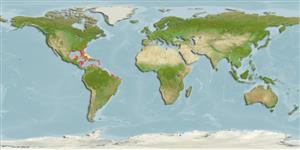Demospongiae |
Tetractinellida |
Tetillidae
Environment: milieu / climate zone / Mức độ sâu / distribution range
Sinh thái học
; Mức độ sâu 17 - 50 m (Tài liệu tham khảo 108813). Tropical
Western Atlantic.
Length at first maturity / Bộ gần gũi / Weight / Age
Chín muồi sinh dục: Lm ? range ? - ? cm
Globular or subglobular, grows up to 4.5 cm across. Specimens between .05 to 1.5 cm are ovoid erect, rarely stalked. Surface covered with 2 to 6 large elevated cup-like depressions (i.e., porocalices) at widths between .05 to 1 cm. Spicules present, radiated with protruding tips covering the remaining surface. Color ranges from orange to yellow, reddish brown, or gray; paler internally. Firm consistency, small specimens softer. Oscules on top of cone-shaped protuberances, smaller than porocalices. Spongin fibers absent (Ref. 85482).
Occurs in deeper rock pavements and hard bottoms (Ref. 85482).
Life cycle and mating behavior
Chín muồi sinh dục | Sự tái sinh sản | Đẻ trứng | Eggs | Sự sinh sản | Larvae
Members of the class Demospongiae are hermaphroditic. Life cycle: The zygote develops into parenchymella larva (free-swimming) before settling down on a substrate where it grows into a young sponge.
Messing, C.. 2010 Interactive sponge guide of Florida. Available online at http://www.nova.edu/ncri/sofla_sponge_guide/index.html. Accessed 9 November 2010. (Tài liệu tham khảo 85482)
IUCN Red List Status
(Tài liệu tham khảo 130435: Version 2025-1)
CITES status (Tài liệu tham khảo 108899)
Not Evaluated
CMS (Tài liệu tham khảo 116361)
Not Evaluated
Threat to humans
Harmless
Human uses
| FishSource |
Các công cụ
Thêm thông tin
Sinh thái dinh dưỡngFood items (preys)
Thành phần thức ăn
Thành phần thức ăn
Các động vật ăn mồi
Population dynamicsSự sinh trưởng
Max. ages / sizes
Length-weight rel.
Length-length rel.
Length-frequencies
Mass conversion
Sự phong phú
Life cycleSự tái sinh sảnChín muồi sinh dụcSự sinh sảnĐẻ trứngEggsEgg developmentLarvae PhysiologyThành phần ô-xy
Human RelatedStamps, coins, misc.
Các nguồn internet
Estimates based on models
Preferred temperature
(Ref.
115969): 22.9 - 27.8, mean 24.8 (based on 78 cells).
